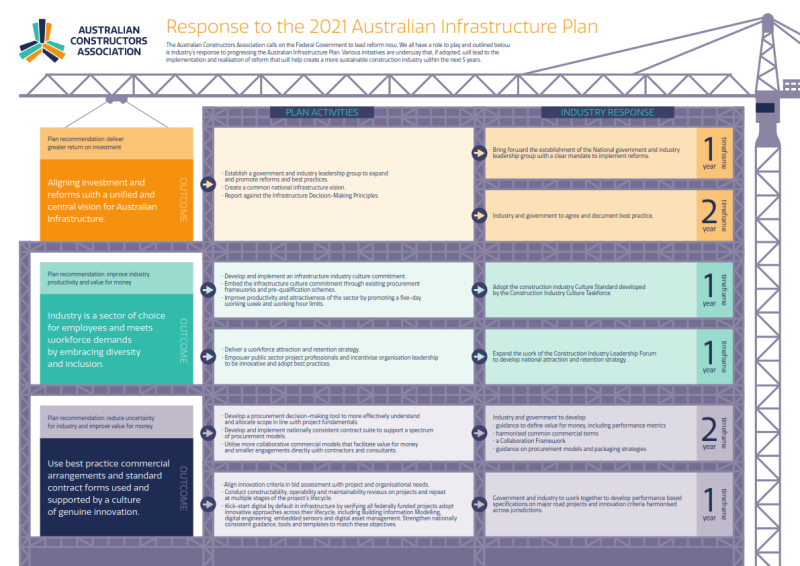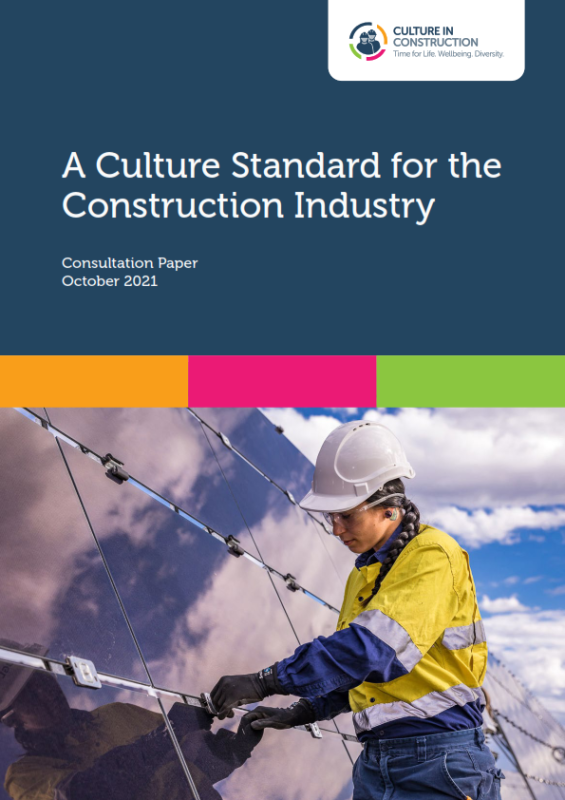CEO Update – October 2021
Posted: 28th October 2021
Posted in: ACA News

Posted: 28th October 2021
Posted in: ACA News
The Australian Government has an ambitious investment agenda. Major public infrastructure activity is expected to double over the next three years, peaking at $52 billion in 2023. This investment provides a great imperative for change, and it must be matched by reform if we are to deliver the project pipeline.
The appetite for reform from all—government and industry—is there. The pandemic has helped to bridge the trust deficit. Contractors and unions have come together to open construction during the pandemic and keep projects moving. Contractors have been working with government to expedite projects and get boots on the ground. Now we need to address the fundamental issues facing the industry that have also undermined our efforts to build capability and capacity.
Reform
There has never been a better time to address the issues and in the process to fundamentally change how we procure and deliver projects.
The issues are well understood and so are the solutions. We just need to get on with reforms that improve the sustainability of the industry. Recognising that everyone part of the industry has a role to play, this month the Australian Constructors Association released our response to the Australian Infrastructure Plan by detailing the activities we are undertaking to improve the industry. Honing in on Chapter 3 of the plan we have provided six responses solutions that, if adopted, will lead to the implementation and realisation of reform within the next 5 years. Many of these involve the work underway by the Construction Industry Leadership Forum and Construction Industry Taskforce.

Culture
This month, as part of the Construction Industry Culture Taskforce, we were extremely pleased to launch the public consultation for the construction industry’s first ever Culture Standard. The Culture Standard puts everything on the table from reducing excessive work hours, improving diversity, attracting new talent and making mental health a priority.
The Culture Standard aims to change the lives of construction workers by ensuring:
Guided by academic research, the Culture Standard has been three years in the making. It is now over to the industry to provide feedback. Once finalised, governments will be called upon to incorporate compliance with the Culture Standard into their standard procurement requirements – so we must get this right!
Our first round of consultation focuses on exploring the practical steps that can be taken to improve the wellbeing of construction workers. Further stages of the consultation will open in the coming weeks focusing on diversity and inclusion and time for life.
The Culture Standard is part of our response to the Australian Infrastructure Plan which recommended its development and implementation. Get involved today.

Productivity and innovation
With international borders closed and high demand for workers when they do open, industry reforms must focus on driving productivity and innovation, as recommended by Infrastructure Australia—so we can do more with less! If we could just halve the gap in productivity growth between the construction industry and other industries over the past 30 years, we could construct an extra $15 billion of infrastructure every year for the same level of expenditure and employ an extra 15,000 people.
Part of the solution is government shifting its mindset to start buying its infrastructure based on best value not lowest cost at the tender box. The current focus on lowest cost can be partially blamed for the slow adoption of productivity enhancing digital technologies and adversarial behaviour in the industry. With a focus on value, we will maximise benefits for the local community, increase training outcomes, drive innovation, reduce our impact on the environment and significantly improve productivity.
Appearing before the House of Representatives Inquiry into Procurement practices for government-funded infrastructure this month, the Australian Constructors Association delivered a strong message in support of our submission and that was that the Federal Government needs to urgently lead reform in how projects are procured and delivered across Australia.
Consistent with recommendations in the 2021 Australian Infrastructure Plan, the creation of a Federally led government and industry collaborative leadership group is needed and it is needed now. As a direct procurer of major projects and as a significant source of funding for jurisdictionally led projects, the Federal Government is best placed to lead the charge. A collaborative approach between Federal and State governments and industry would result in a more coherent implementation of reforms through sharing and adoption of best practice.
Again, recognising the important role of all stakeholders, the Australian Constructors Association has been working with the NSW and Victorian Governments through the Construction Industry Leadership Forum in promoting collaborative procurement models and developing a framework to better define value for money than just lowest price.
Through the Construction Industry Leadership Forum, we have seen a greater uptake of successful collaborative frameworks and programs of work such as the Level Crossing Removal Program in Victoria, the Sydney Metro Greater West early identification of risk pilot and the incorporation of an Incentivised Target Cost model at the heart of the Melbourne North East link Public Private Partnership.
This state-based reform is good news for the industry, but broader adoption is needed, and this is where the Federal Government comes in. To be clear, the Federal Government is not being tasked with solving the problems—the problems are shared, and a joint response is required. The Federal Government simply needs to coordinate and incentivise reform.
Construction blog
This month’s ACA blog was written in response to suggestions that one way to address the problem of shortages is to break up large projects into smaller packages of work that can be undertaken by ‘Tier 2’ and ‘Tier 3’ contractors.
Whilst no definition has ever been agreed, the tier system has been used to describe different sizes of contractors based largely on the revenue they generate. It does not take into account important things like whether the revenue generates profit, how much profit is invested in Australian training and innovation, the diversity within the business, and the resources and technical expertise that it can call upon.
In short, a focus on giving more or less work to different tiers will not help address the fundamental problems of the construction industry that are impacting on its ability to undertake the pipeline of work ahead of it.
The construction industry operates as a complex system that is not easily capable of being broken down and categorised. Projects are essentially built by many interconnected teams of people fed by long supply chains that are ultimately managed by contractors. It therefore stands to reason that in order to improve project outcomes, there needs to be a focus on optimising the system as a whole and not just one component.
As a model client, there are a number of simple actions governments could take that would lead to cascading improvements throughout the whole complex system of the construction industry. Read this month’s blog to find out what these actions are.
Women of the ACA initiative
The Australian Constructors Association has been profiling the careers of women from across our membership to inspire others to join and to develop their careers in the construction industry. There are a diverse range of roles in the industry, and we hope that through this initiative we can successfully showcase these roles and help others to navigate the industry. Please show your support by engaging with us through LinkedIn and view the profiles on our website.
Australian Construction Achievement Award
Entries are open for the 2022 Australian Construction Achievement Award (ACAA). The ACAA is industry’s most prestigious award recognising the best construction projects, delivered by the nation’s very best construction companies.
In approaching its 25th year, we will soon be making an exciting announcement about the gala award dinner to be held on 4 May 2022. Stay tuned.
Entries close on 28 January 2022. Enter now.

2021 Winner – Zero Cost Energy Future by Enerven
This award highlights the innovative thinking required to deliver this world-first program, and the dedication, teamwork, and drive from the team to successfully manage this challenging program of works. We are extremely proud of this award and the legacy this program leaves on our industries
Leon Cocchiaro, Zero Cost Energy Program Director, Enerven
2020 Winner – New Museum Project (WA Museum Boola Bardip) by Multiplex
We are honoured to have won the 2020 Australian Constructors Association (ACAA) Achievement Award for the New Museum for WA (WA Museum Boola Bardip). The award is fantastic recognition for Multiplex and the Western Australian team who were involved throughout the build. The ACAA award reflects the incredible journey we have been on with our many stakeholders to bring this world-class project to life and is an inspiring achievement for Multiplex business wide.
Chris Palandri, Regional Managing Director, Multiplex Constructions
New member announcement
Before concluding this month’s blog, I am delighted to announce Calibre Group has become a member of the Australian Constructors Association. Calibre Group is a trusted partner, and its people first approach is aligned with our strategic direction.
The 25 per cent growth in our membership this year reflects the growing trend of organisations coming together to address the issues that are holding the construction industry back.